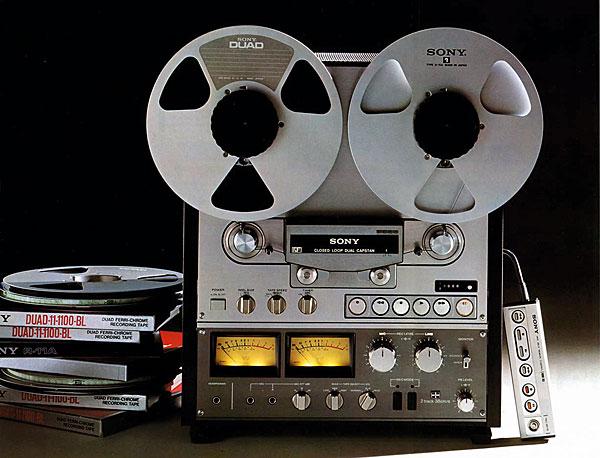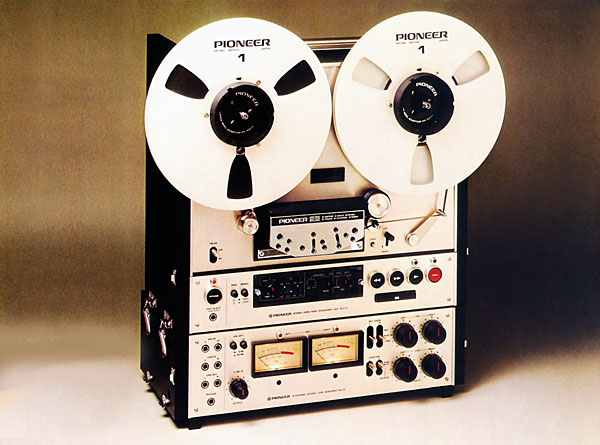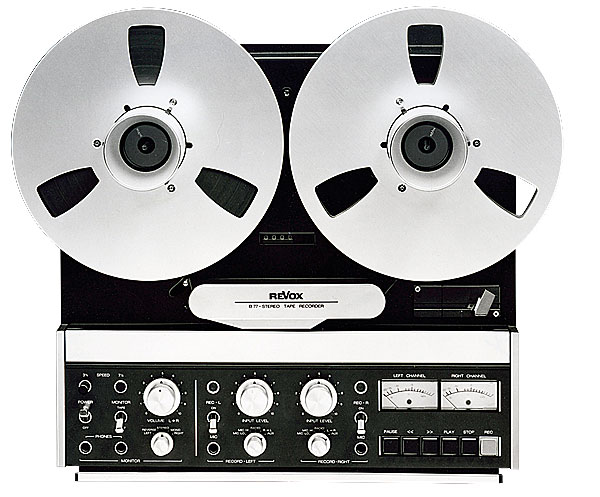Reel-To-Reel Recorders

 Martin Colloms hears four top-quality open-spool decks
Martin Colloms hears four top-quality open-spool decks
The last year or so has seen the emergence of a new generation of high-quality open-reel tape decks, of which four are investigated here. As the price span ranges from £500-£600 for the Sony and Revox models to £850 for the Technics and £950 for the basic Pioneer assembly, these units are not strictly comparable, although their relative performances are nonetheless interesting.
All four recorders subscribe to the 'professional' format, namely a 26.5cm diameter maximum reel capacity with at least two high speeds (19 and 38cm/sec), and a two-channel half-track format on 6.25mm (¼in) tape. However, strictly speaking they should be called 'semi-professional', as although they are essentially capable of master quality recordings, they do differ from true studio machines in several respects. For example, the input and output connections of professional machines are generally balanced-line with Cannon or similar type sockets. In contrast, the review models are all unbalanced, with phono and DIN-type inputs and outputs, plus lower line levels.

The Revox B77 reviewed is the 'high speed' version with IEC equalisation, while the Pioneer deck may be switched to operate in either IEC or NAB record/playback EQ standards at the higher speed. The Technics and Sony are both fixed in NAB. (IEC equalisation allows a little more treble boost on record than NAB, while the consequent relative reduced treble on replay endows the IEC machine with a couple of decibels less replay hiss.)
Both Technics and Sony decks have a second built-in replay head which allows the replay of ¼-track stereo tapes, which is an important point for the purchaser with an established tape library. The Pioneer will also play ¼-track tapes, but less conveniently via the interchange of complete head-block assemblies. But this substitution also allows the deck to record in the ¼-track format and, indeed, if a second preamp/control unit is employed, full four-track, four-channel working is possible with the Pioneer model. Versatility is clearly the keynote of this unusual recorder.
Remote Control
All the decks have solid-state or full relay control of transport functions, with the required modes selected by light-action buttons that are duplicated, if required, by cable-connected remote control units. The delayed logic systems incorporated also allow sequential and random actuation of any function except 'record' (for which the usual interlocks are provided), without confusion or any tape mishandling. Other common features include a basic system design for vertical operation, although the decks can be used horizontally. However, the controls, tape paths and meter systems are all most accessible to hand and eye if the machines are vertically positioned on a rack or shelf of convenient height.
Other points common to all four machines are features now taken for granted with high-quality decks. For example, a three-motor transport, one for each reel in addition to the capstan. Three magnetic heads are also employed – erase, optimum record and an optimum replay. Good tape handling goes almost without saying, and all have tape back-tension switches to allow for small-core reels; the exception to this is the Technics deck, whose special tensioning will accommodate these.

Pioneer RT2022 (RT2044 – four channel)
Designated individually as the RTU11 tape transport and TAU11 amplifier units, together this dual combination is called the RT2022. Without factory modification or lab alignment this deck can, with an additional head-block and control amplifier, perform in stereo/mono record or playback modes, ½- or ¼-track format; four-channel play/record with ¼-track; NAB equalisation at 19cm/sec and 38cm/sec speeds; IEC equalisation at 38cm/sec, with cross-dubbing, echo, multi-track and sound-on-sound.
To aid multi-tracking, the record heads may also be used for monitoring to allow accurate synchronisation of the second track. Furthermore, several self-correction features are built into the transport section. A test oscillator with 1kHz and 10kHz tones allows selection of optimum tape equalisation and bias settings, this oscillator together with the bias settings being adjustable from the front panel, protected by a removable smoked Perspex cover.
For four-channel operation the second TAU11 unit clips beneath the first by means of tensioned latches, with recesses provided in the top panels to stow the interconnecting cables. Almost every input and output socket is duplicated, and when the four-channel system is fully assembled the rear resembles a telephone exchange! However, Pioneer has thoughtfully supplied colour-coded cables so that links may readily be traced. What's more, several inputs and outputs are also brought forward to the front panel by means of jack cables, in order that supplied signals may be quickly routed from one track to another.
Mechanically, the deck is robustly constructed with a die-cast frame and a 5mm-thick machine alloy main bed-plate. Two eddy/induction hybrid reel motors are used, plus a hysteresis synchronous capstan motor driving the flywheel via a resilient belt. Damped tension arms smooth the tape transport and the heads maintain contact with the tape by back-tension alone. A flutter roller is also incorporated. Finally, the deck's side panels are finished in black leatherette though their appearance, reinforced by the massive carrying handle and chrome latch fittings, visually suggests location recording rather than a domestic hi-fi installation.

Revox B77
The successor to the A77, the B77 represents a development of the older model rather than an entirely new design. A number of changes have been made, significant enough to say at the outset, that while I had considerable respect for the A77, I did not personally favour certain aspects of its performance, notably poor level matching, premature overload of electronics and poor control ergonomics. However, all these have been resolved in the new model, as well as refinements made.
For example, the capstan motor – the famous direct-drive tachogenerator design – has been further developed and is now closer to that of the Revox A700. The deck will also accept an accessory that allows fine control of capstan speed and hence of musical pitch, when required. Improvements to head quality have resulted in increased life as well as a more uniform frequency response, and the transport section has now eliminated those occasionally troublesome relays, with their function now carried out by semiconductors, bringing an expected increase in reliability.
























































